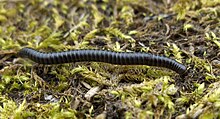Tachypodoiulus niger
| Tachypodoiulus niger | |
|---|---|

| |
| T. niger walking over moss | |

| |
| T. niger in defensive posture | |
| Scientific classification | |
| Domain: | Eukaryota |
| Kingdom: | Animalia |
| Phylum: | Arthropoda |
| Subphylum: | Myriapoda |
| Class: | Diplopoda |
| Order: | Julida |
| Family: | Julidae |
| Genus: | Tachypodoiulus |
| Species: | T. niger
|
| Binomial name | |
| Tachypodoiulus niger | |
Tachypodoiulus niger, known variously as the white-legged snake millipede or the black millipede, is a European species of millipede. It is very similar to other species such as Cylindroiulus londinensis, from which it can be reliably distinguished only by studying the shape of the telson.[2] It occurs in Ireland, Britain, Spain, France, Benelux, Germany, Switzerland, Austria and the Czech Republic,[1] and is especially common on chalky and limestone soils.[2]
T. niger has a roughly cylindrical shiny black body, with around 100 pairs of contrasting white legs[3] on its 41–56 body segments.[2] It lives in leaf litter, under bark or in moss, and feeds on encrusting algae, detritus[3] and sometimes fruit such as raspberries.[2] Predators of T. niger include the centipedes Lithobius variegatus and Lithobius forficatus[3] and hedgehogs.[4]
T. niger is most active from one hour after sunset to one hour before sunrise, although in summer it also becomes active in the afternoon.[5] Like many millipedes, T. niger coils itself into a spiral, with its legs on the inside and its head in the centre, when it is threatened,[2] but it can also flee with sidewinding movements.[6]
References[edit]
- ^ a b "Tachypodoiulus niger (Leach 1814)". Fauna Europaea. Archived from the original on March 25, 2014. Retrieved June 10, 2012.
- ^ a b c d e Stuart M. Bennett (2000). "Tachypodoiulus niger".
- ^ a b c "White-legged snake millipede – Tachypodoiulus niger". Natural England. Archived from the original on September 27, 2007. Retrieved June 28, 2007.
- ^ B. Lundrigan & J. Bidlingmeyer (2000). "Erinaceus europaeus: western European hedgehog". Animal Diversity Web. University of Michigan.
- ^ Barundeb Banerjee (1967). "Diurnal and seasonal variations in the activity of the millipedes Cylindroiulus punctatus (Leach), Tachopodoiulus niger (Leach) and Polydesmus angustus Latzel". Oikos. 18 (1): 141–144. doi:10.2307/3564643. JSTOR 3564643.
- ^ "Tachypodoiulus niger vs. Julus scandinavius" (in German). diplopoda.de.
